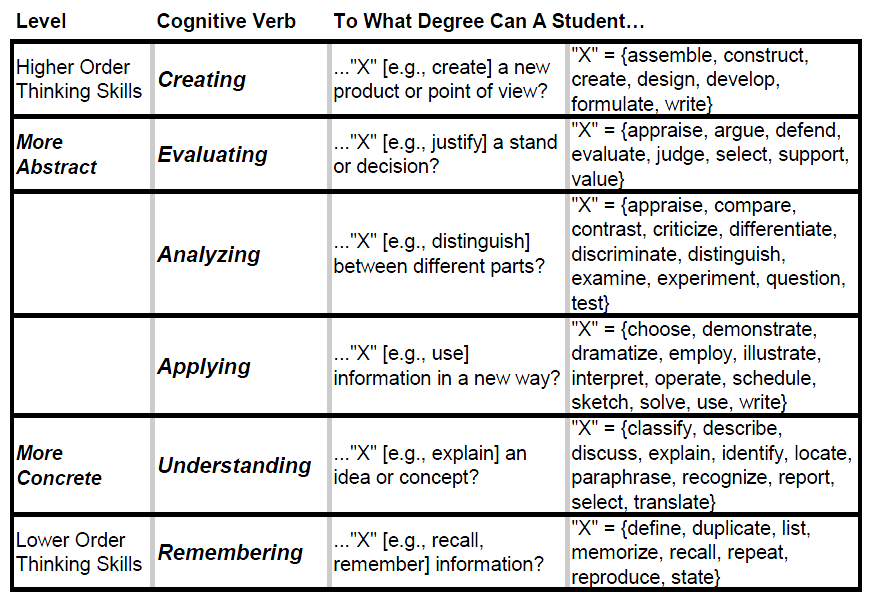Bloom's Taxonomy - A Classification of Cognitive Processes
A purpose of education is the development of student "thinking" skills
Thinking Skills in Bloom's Taxonomy
(illustration by Scott Brande)
There are many purposes of education, one of which is to help guide the development of our "thinking" skills (illustrated). So as we move through our educational experiences, we come to better understand the world around us. For example, in the classification of a group of objects (such as stones, fossils, rivers, species, universities, etc.), that before we can group these objects, we must accurately observe them and recognize characteristic similarities and differences.
Bloom's Taxonomy - a classification of "thinking" skills
In 1956, Benjamin Bloom, an educational psychologist, proposed a framework for understanding the diversity of thinking skills. "Bloom's Taxonomy" (or alternatively, in it's updated form, "Bloom's Revised Taxonomy"), has generated an immense record of discussion in the professional literature about education and "best practices" around which there is no universal consensus. A quick introduction to Bloom's Taxonomy (original and revised) may be found in these sources.
Learn More
Andrew Churches more extensive wiki of Bloom's Taxonomy -
application of Bloom's concepts to web-related technologies
Rex Heer's Model of Learning Objectives
Integrating Bloom's Taxonomy with Video Tutorials
The pedagogic value of video may be significantly enhanced with a tutorial designed to guide student thinking across the spectrum of cognitive levels, from the more concrete to the more abstract..
A model for the application of Bloom's taxonomy to the design of video tutorials has been proposed by Brande and Wiese (in preparation). Here we provide a brief summary.
Goals for viewing video based on lower order thinking skills (remembering, understanding)
- student will be able to recall particular facts, be able to state, list, or duplicate recalled facts
- student will be able to identify and report or paraphrase facts, and use facts to discuss or explain something
Examples of video topic and application of thinking skills
- video snip of a volcanic eruption with a debris cloud, lava flow, or pyroclastic surge - student is able to recall and describe characteristic appearance and motion (action) of each type
- video snip of groundwater flow through aquifer - student is able to recall and identify location (with respect to the surrounding strata and the earth's surface) and direction of groundwater flow
Examples of videos selected for conveying factual material
- eruption of Mount Etna - (after video begins playing, click speaker icon to silence the loud audio track)
- world's most amazing rock
Goals for viewing video based on middle order thinking skills (applying, analyzing)
- student will be able to use facts and explanations to illustrate or sketch and interpret something
- student will be able to use facts and explanations to compare, contrast, distinguish or differentiate among things
Examples of video topic and application of thinking skills
- video snip of a volcanic eruption with a debris cloud, lava flow, or pyroclastic surge - student is able to illustrate or sketch characteristic appearance; compare and contrast the characteristics of flow among these types
- video snip of contaminated groundwater flow through aquifer - student is able to examine and assess the potential widespread effects of contaminated groundwater
Examples of videos selected for middle order thinking skills
- what are characteristics of a pyroclastic flow
- groundwater flow of contamination in model of Edwards Aquifer
Goals for viewing video based on high order thinking skills (evaluating, creating)
- student will be able to argue, evaluate, support a position
- student will be able to design, create, develop a new experiment
Examples of video topic and application of thinking skills
- video snip of a volcanic eruption with a debris cloud, lava flow, or pyroclastic surge - student is able to evaluate the potential for future volcanic activity based on the historical record
- video snip of groundwater flow through aquifer - student is able to evaluate impacts of excessive groundwater withdrawal rate on water table drawdown and aquifer salinity

